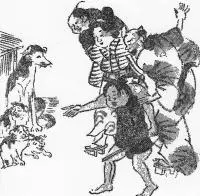There are a multitude of urban legends and folktales from Japan. So many, that today I’m focussing exclusively on supernatural urban legends, and even then, this is by no means an exhaustive list. Want more? Let me know in the comments or over on Twitter and I’ll make it happen.
1. Aka Manto
Aka Manto, or Red Cape in English, hangs out in and haunts the women’s bathroom. It’s said he has devilishly good looks, so he wears a mask to hide his identity, having previously been stalked for being too damn attractive in life. I guess the mask is the whole supernatural equivalent of hiding from the paparazzi, although why he can’t use his ghostly powers to conceal himself I’m not sure. Anyway, when someone uses the last stall in the bathroom, Aka Manto will make himself known and, assuming the toilet occupant doesn’t bolt up off the toilet and leg it, Aka Manto will ask whether they want red or blue paper—a pretty odd thing to do but there’s a hell of a lot of questions when it comes to supernatural entities and Japanese urban legends. If the person answers red they’ll meet a bloody death, and if they answer blue they’ll be suffocated to death. Not much of a choice, huh?
You may be wondering if there’s some sort of workaround that doesn’t involve death, and as luck would have it there is. If you answer yellow then Aka Manto will dunk you in your own urine, which isn’t ideal, but as far as I understand you don’t actually die so this seems preferable to either red or blue. If you answer any other colour, say purple, green, maroon (you know colours, why am I listing them?) then Aka Manto will drag you down to hell… which doesn’t sound like a great option either. So, how to avoid death, hell, and being covered in piss? Turns out you just refuse anything Aka Manto offers. This really is a case of just ignore him and eventually he’ll go away. A little anti-climactic and hardly a boss level fight, but hey, at least you’re still alive.
There are various versions and modifications of the original Aka Manto legend, including one in which he’ll ask if you want a red or blue vest or cloak and then rip the skin from your back or decapitate you. It’s safe to say that Aka Manto has some serious anger problems. He’s also quite the celebrity in Japan, having appeared in numerous television episodes, animes, and even the video game Shin Megami Tensei: Devil Children.
2. Toire no Hanako-san
Aka Manto isn’t the only malevolent spirit to haunt Japanese bathrooms, oh no. Toire no Hanako-san (literally Hanako of the toilet) is so renowned that when I asked one of my Japanese friends if she knew any good Japanese urban legends (because that’s how I do research) she immediately mentioned Hanako-san. Hanako-san also haunts the female bathroom but, in this case, specifically in elementary schools. (Pro-tip, if you’re female, in Japan, and need the toilet, it might be a decent idea to use any bathroom but the womens’.) The case of Hanako-san is less scary and far more tragic than Aka Manto. See, the legend goes that Hanako-san was a former student who was bullied so badly she committed suicide—and now she haunts the bathroom. There are numerous versions of the Hanako-san legend. In perhaps the most popular, calling upon her spirit is a rite of passage for children. You’ll find her in the third stall on the third floor and you have to knock on the door three times to summon her (I guess three really is the magic number) before asking “Are you there, Hanako-san?” She’ll answer in the affirmative and if you choose to enter you’ll see her—a small girl in a red skirt with gleaming melancholic eyes. And if you do see her give her a bloody big hug, after all that bullying, she could do with a mate.
There are other versions of the Hanako-san legend that are just as depressing, such as her being the ghost of a girl who died during a World War II air raid or a murder victim—in some versions at the hands of her own parent, in others a complete stranger.
There are further variants still, specific to different prefectures. The award for ‘smoking the funkiest substance’ goes to the good people of Yamagata prefecture, who reckon that upon entering the stall you’ll find a three-headed lizard who was mimicking Hanako’s voice. Unfortunately, the three-headed lizard isn’t there for conversation, it’ll promptly eat you—sayonara! Iwate and Kanagawa prefecture have more desirable variants that don’t involve getting eaten by a three-headed lizard or indeed any creature—in the former, once Hanako-san is called a white hand will appear and in the latter, a blood-stained hand. Definitely unnerving but preferable to being eaten alive.

3. Gozu
Things got pretty heavy with Hanako-san, so let’s try and lighten the mood with Gozu, i.e. Cow Head (Ox Head in some variants). The legend goes that there exists a fictional story titled ‘Cow Head’, the problem is that upon hearing the story people are so overcome by fear they shake for days until they die. Obviously, I don’t know the exact details because I’m not writing this from the grave, but there exist many variants of the legend including a teacher regaling a group of bored school children with the tale (if that’s not a welfare issue, I don’t know what is). Incidentally, the urban legend Gozu has nothing to do with the 2003 Takashi Miike film.
4. Jinmenken
 Jinmenken are dogs with human-faces that were first said to be seen in rural Japan, then later starting sprinting around urban areas and highways at night. In the 80s, there were even numerous sightings of jinmenken in the backstreets of Shibuya (one of the most populated areas in Tokyo). Jinmenken can also talk, so if you happen to see one you could strike up a conversation. That being said, whilst they aren’t likely to kill you, jinmenken are said to be pretty rude, so don’t expect to get much out of the chat. Furthermore, they induce feelings of dread and despair in those who see them and are even considered as bad omens indicating near-future disaster.
Jinmenken are dogs with human-faces that were first said to be seen in rural Japan, then later starting sprinting around urban areas and highways at night. In the 80s, there were even numerous sightings of jinmenken in the backstreets of Shibuya (one of the most populated areas in Tokyo). Jinmenken can also talk, so if you happen to see one you could strike up a conversation. That being said, whilst they aren’t likely to kill you, jinmenken are said to be pretty rude, so don’t expect to get much out of the chat. Furthermore, they induce feelings of dread and despair in those who see them and are even considered as bad omens indicating near-future disaster.
Throughout the Edo Era there were actually people who claimed to have seen jinmenken, to such a point there were supposedly news articles on sightings from time-to-time. Though there’s speculation that those said to have seen jinmenken likely just bumped into a Japanese macaque because, you know, snow monkeys are always being confused with doom-bringing dogs with human faces … Still, there are other theories, perhaps there’s a more plausible explanation? Not so fast, one such theory is that jinmenken are in fact the spirits of traffic accident victims or dogs possessed by evil spirits. I guess, I’ll stick with the snow monkeys.
5. The Fatal Fare
We’re moving back to something darker, but The Fatal Fare should only concern you if you’re a taxi driver in Japan. According to the legend, a person suddenly appears and hails a taxi—this should set off alarm bells, as people aren’t known to appear out-of-nowhere. Still, taxi drivers are often friendly in Japan, so the driver is likely to let our miraculously materialising friend in. The mysterious ‘out-of-nowhere’ passenger requests a ride somewhere the taxi driver hasn’t heard of, but the passenger reassures the driver offering directions. So, being all accommodating, the driver agrees. The journey lasts a while as they get further-and-further from the town/city/wherever they started off. Eventually the taxi driver turns around (never take your eyes off the road, folks) to the mysterious passenger, only to see (or not) they’ve pulled their vanishing trick once again. Turning back to the steering wheel, the driver realises he’s about to head off a cliff. The moral of the story? Don’t trust people who appear out-of-nowhere, always look at the road, and next time someone asks you to take them somewhere you don’t know, use a GPS.

6. Kuchisake-onna
Kuchisake-onna A.K.A. the Slit-mouthed Woman is so terrifying, Koji Shiraishi made a mediocre* film about her in 2007 called Carved: The Slit-Mouthed Woman in the West. (If you haven’t watched any Koji Shiraishi films start with Noroi: The Curse instead.) Slit-mouthed Woman wears a medical mask (a common sight in Japan) that covers up her (you guessed it) disfigured mouth. She gets a kick out of approaching strangers—mask still on—and asking, ‘am I beautiful?’ Now, if you think back to Aka Manto, you know you have to be careful in how you answer these pesky supernatural entities, so don’t just go with your gut, take the time to consider your answer. If you say ‘no’ she’ll kill you with scissors, which seems a pretty unpleasant way to go and one hell of an overreaction. Say ‘yes’ and she’ll take the mask off and ask again. If you stick with your original answer and go with the affirmative, she’ll use the scissors to modify your mouth so you can join her in slit-mouthed adventures**. If you twist to ‘no’ she’ll cut you in half. So, how the hell to get out of this predicament without death or body modification? You just need to tell her she’s mediocre or average or so-so or words to that effect. Turns out there’s often a solution when it comes to Japanese urban legends, which in a country with a fondness for rules, order, and harmony, kind of makes sense.
 But what of the Slit-mouthed Woman’s origin story? It turns out her injuries were sustained via her husband. In a story that dates back to the Heian period, he discovered she was having an affair, so used a big-ass samurai sword to cut her mouth ear-to-ear then asked, “who will think you are beautiful now?” (An unnecessary question to add, though, presumably rhetorical.) For some reason, the story and alleged sightings really took off again in 1979, to such a point there were reports of children only being allowed home in groups escorted by teachers. The slit-mouthed woman is among the most notorious and widespread Japanese urban legends—there have even been sightings of her outside of Japan.
But what of the Slit-mouthed Woman’s origin story? It turns out her injuries were sustained via her husband. In a story that dates back to the Heian period, he discovered she was having an affair, so used a big-ass samurai sword to cut her mouth ear-to-ear then asked, “who will think you are beautiful now?” (An unnecessary question to add, though, presumably rhetorical.) For some reason, the story and alleged sightings really took off again in 1979, to such a point there were reports of children only being allowed home in groups escorted by teachers. The slit-mouthed woman is among the most notorious and widespread Japanese urban legends—there have even been sightings of her outside of Japan.
*I don’t think he set out to make a mediocre film as such, that’s just my verdict.
**She doesn’t actually require you to join her, but I like to think you’d be BFFs, bonded by your slit-mouths (which definitely doesn’t sound PC, but hey, that’s the name of the legend).
7. Teke Teke Girl
There are certain parallels between Teke Teke Girl and the Slit-mouthed Woman. Both are victims of extreme violence or murder and both are now out to harm or kill anyone they encounter (provided the would-be victim doesn’t provide the right answer and escape scot-free). Teke Teke Girl was thrown onto the railway line and cut in half by an oncoming train, so now she crawls around on her elbows and hands—teke, teke—carrying a scythe (don’t question the logistics or ask where the hell she got the scythe from), ready to hurt everyone she meets. In some versions she asks, “Where are my legs?” Tell her and you’ll survive. But if not? Well, prepare to be sliced at the torso.
Totally shameless plug: I used a combination of the Teke Teke Girl and Red Room Curse Japanese urban legends for my story "Off Track", which you can listen to on The Other Stories Podcast.
Now it’s over to you. What are your favourite supernatural urban legends from Japan? Are there any books or films you’d recommend that concern a Japanese urban legend? Do you want to see more Japanese urban legend articles? See you in the comments!

About the author
Michael David Wilson is the founder of the popular UK horror website, podcast, and publisher, This Is Horror. Michael is the author of the novella, The Girl in the Video, and the novel, They’re Watching, co-written with Bob Pastorella. His second novella, House of Bad Memories, lands in 2021 via Grindhouse Press. His work has appeared in various publications including The NoSleep Podcast, Dim Shores, Dark Moon Digest, LitReactor, Hawk & Cleaver’s The Other Stories, and Scream. You can connect with Michael on Twitter @WilsonTheWriter. For more information visit www.michaeldavidwilson.







